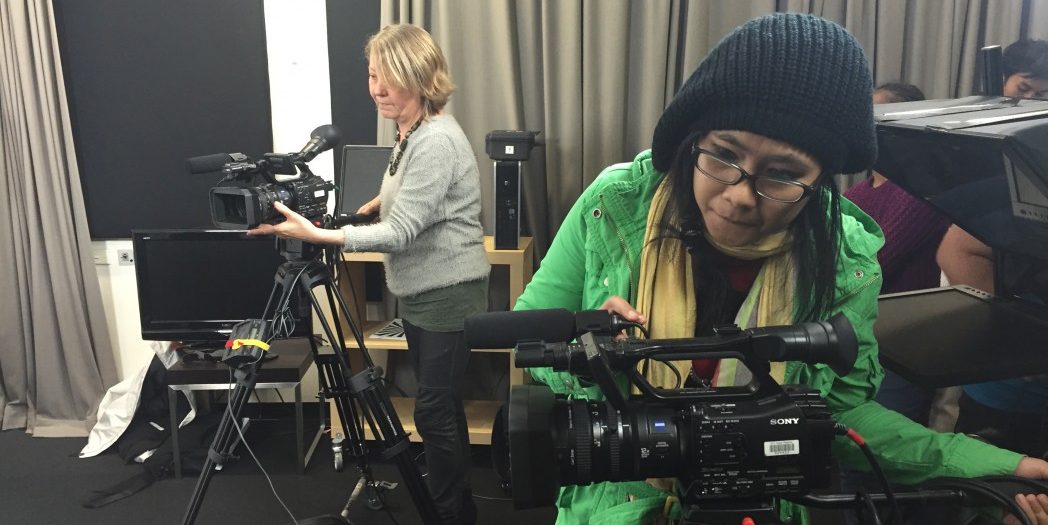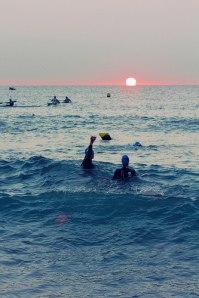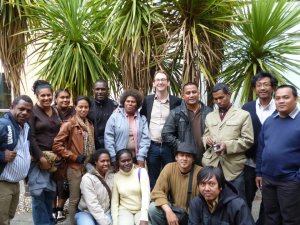
The author, flanked by Rikamati Naare of Kiribati and Alain Simeon of Vanuatu in Melbourne. Picture: Luke Guterres
Port Moresby, Sunday 23rd October 2011. It was 5.30am and my flat at Kaubebe Street, Boroko, came awake. I got up from my bed and looked out the window. Dawn was here. I showered, got dressed and checked my bag again to make sure that I had everything I needed.
My passport was on the table with my airline ticket. I was leaving for Melbourne, Australia to attend a five week training program. I grabbed my bag and with my family in tow, we jumped into the car. Graham, my neighbour, drove us to the Jackson’s International Airport, where I got off and said goodbye to everyone.
I hate flying. To tell you the truth, the only bit of flying that I like is the take off. I like the hormones rushing through my body when the huge planes run down the runway, picking up speed as they go to lift off the ground.
So when the Air Niugini Port Moresby to Cairns flight was airborne, I decided that sleep was the best way to pass my time for the next one and half hour.
I was awaken by the voice of the air hostess and realised that we were landing at the Cairns International Airport. I had to get a connection flight to Melbourne in about one and half hour so after clearing Customs, I headed for the domestic terminal. I arrived, only to find that it was a lot bigger than what I am use to at Jackson’s. I asked someone who was dressed like a security guard where I should check in and he pointed the way to me. When I arrived at the Qantas check-in counter, I remembered what my good comrade Frank Genaia told me after returning from Sydney recently. I looked for the machines that were to check passengers in and found several queues in front of what looked like ATM machines. When it was my turn, I asked the lady in uniform next to the machine for help.
A few minutes later, my boarding pass was coming out of the machine. I picked it up and went over to the counter where I dropped my bag. My flight to Melbourne was going to take off in a short time and I rushed here and there, looking for the gate where I was to go in to board the flight. It was not long when I found it.
I found myself, squeezed in between two huge guys at the tail end of this huge jet plane for the four hours flight to Melbourne. As the plane flew south, heading for this 200 year old city, I allowed my mind to go to work. I was too excited to sleep because I had never been to Melbourne. All my visits to Australia had always terminated in Sydney. I had been to Canberra only once but it was a long time ago.
After what seem like hours, I felt the plane start its decent. I knew we were getting close to my destination. This was confirmed soon by the pilot who announced that we had arrived in Melbourne half an hour early. I was not to know that arriving this early will present a problem for me. I was to find out later.
Very soon, the huge plane touched down and was taxing into the tarmac. It was a good thing that I had taken one of the seats in the last row, for as one of the last passengers to get out of the plane, it was easy for me to follow the others into the tarmac. Pushing a trolley with my bag, I went out of the arrival gate, expecting to see someone from the Asia Pacific Journalism Centre to be there to pick me up but there was no sign of anyone.
I walked up and down, pulling my bag behind me. Still no one. I went back into the arrival lounge, checking everyone who was standing there, holding up small signs with names of passengers they were waiting to pick up, written on them. My name was not on any of them. I walked outside again and waited, all the time telling myself not to panic.
After what seem like hours, I decided to ask for help. I asked someone who looked like a driver of one of those tour buses who was standing not too far off from where I was.
“Mate, how much will it cost me to go to this address,” I asked showing him the APJC address.
The man consulted two other men, who looked like they were in the same business, came back to me and told me that the place I wanted to go was not too far away.
He told me that it will cost me $65. I agreed to pay and we set off for APJC. After half an hour later, Francis (he introduced himself to me in the car) pulled into APJC. Francis waited for me while I went up to the house and knocked. I knocked several times and no one answered the door. I started getting worried. It was getting late and the wind was chilly. I could feel the cold biting into my skin. Francis said he will wait with me. I was comforted as I did not want to stand there at this strange place by myself.
Soon a car pulled up and a man jumped out. I recalled seeing him somewhere before but I could not remember. “You must be Peter,” he said with a smile, extending his hand to me. “I am John Wallace”.
We shook hands. He realised I had come in another car and told me there was supposed to be someone at the airport to pick me up. I told him I did not see this someone and I could not hang around because it was getting late and I had to find my own way to APJC.
John Wallace turned to Francis and asked him how much he was charging me. When John heard the price, he shook his head, telling Francis that it normally cost $50 from the airport to APJC. Nevertheless, John parted with the fare and told Francis to drop me at the hotel which was going to be my home for the next three weeks. Jee, the man who was to pick up me at the airport caught up with me at the hotel. He told me that he had gone to the airport but found that my plane had arrived half an hour early and that I had left. I forgave him and told him not to worry. It was not his fault.
I moved into Finlay Place on Lygon Street and into one of the most delightful parts of Melbourne.
That evening, I walked to the balcony on the fourth floor of my hotel and looked across Melbourne. The lights had come on but I could not see where the lights end and as I stood there, looking across the city, my nose was picking up this rich aroma in the cool air. Food! I was picking up the scent of good cooking.
I looked down. All along Lygon Street, it was a hive of activity. Restaurants of all kinds were open for business. At each place, a lot of happy people were seated around tables, sipping wines, eating and conversing. Their laughter filled the air and floated up to where I was.
A happy thought struck me. I did not get lost and had arrived safe in Melbourne. It was time I went down and check those restaurants out.








